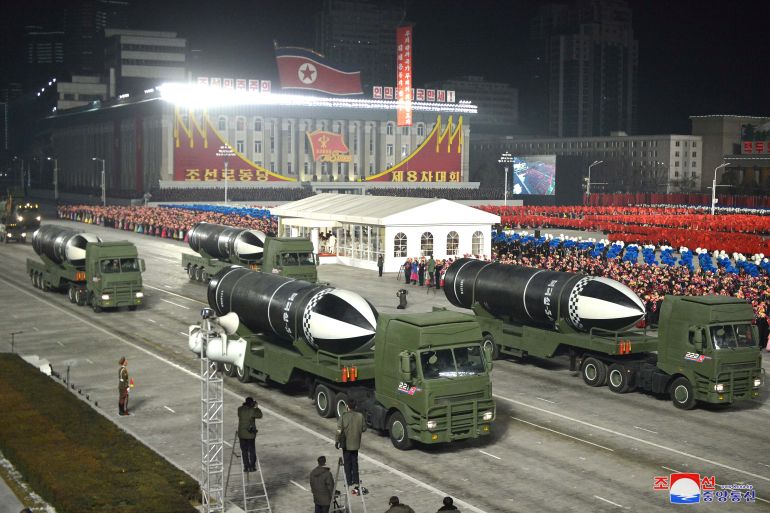N Korea further developed nuclear weapons programme in 2020: UN
Monitors believe Pyongyang is using money stolen in cyber-hacks to fund the programme and might be getting help from Iran.

North Korea maintained and developed its nuclear and ballistic missile programmes throughout 2020 in violation of international sanctions, helping fund its activities with some $300m stolen through cyber-hacks, according to a United Nations report.
The report by independent sanctions’ monitors, which was obtained by both Reuters news agency and AFP, said Pyongyang “produced fissile material, maintained nuclear facilities and upgraded its ballistic missile infrastructure” while continuing to seek material and technology for those programmes from abroad.
Keep reading
list of 4 itemsSenior North Korean diplomat defects to South: Reports
Fewer North Korean defectors as COVID helps regime tighten grip
Blinken says US will review North Korea policy, consider aid
A US State Department spokesperson said on Monday the administration of President Joe Biden, who took office last month, planned a new approach to North Korea, including a full review with allies “on ongoing pressure options and the potential for any future diplomacy.”
His predecessor Donald Trump had boasted of his ability to work with North Korean leader Kim Jong Un and the two men met three times in 2018 and 2019. Their summitry failed to achieve a breakthrough, however, as talks collapsed over US calls for Pyongyang to give up its nuclear weapons and North Korea’s demands for an end to sanctions.
In the past year, North Korea has displayed new short-range, medium-range, submarine-launched and intercontinental ballistic missile systems at military parades, the UN report noted. Last month, it unveiled what it said was ‘the world’s most powerful weapon‘ at a military parade in Pyongyang to mark the 8th ruling party congress.
The report said an unnamed member state had assessed that, judging by the size of North Korea’s missiles, “it is highly likely that a nuclear device” could be mounted onto long-range, medium-range and short-range ballistic missiles.
“The Member State, however, stated it is uncertain whether the DPRK had developed ballistic missiles resistant to the heat generated during re-entry,” into the atmosphere, the report said, using the acronym for the Democratic People’s Republic of Korea, North Korea’s formal name.
While there were no nuclear or ballistic missile tests in 2020, Pyongyang “announced preparation for testing and production of new ballistic missile warheads and development of tactical nuclear weapons.”
North Korea’s UN mission in New York did not immediately respond to a Reuters’ request for comment on the report.
Cooperation with Iran?
North Korea blew up tunnels at its main nuclear test site, Punggye-ri, in 2018, saying the decision was proof of its commitment to end nuclear testing. However, an unidentified member state told the UN monitors there were still personnel at the site, showing it had not been abandoned.
According to an unidentified country, North Korea and Iran have resumed cooperation on long-range missile development projects, including the transfer of critical parts, the monitors said. The most recent shipment was last year, they said.
In a December 21 letter to the UN sanctions monitors, annexed to the report, Iran’s UN Ambassador Majid Takht Ravanchi said a “preliminary review of the information provided to us by the (experts) indicates that false information and fabricated data may have been used in investigations and analyses.”
North Korea has been subject to UN sanctions since 2006. The measures have been strengthened by the 15-member Security Council over the years in a bid to cut off funding for Pyongyang’s nuclear and ballistic missile programmes. The monitors’ reports are to help ensure compliance.
The UN monitors assessed that in 2020 North Korea-linked hackers “continued to conduct operations against financial institutions and virtual currency exchange houses to generate revenue” to support its nuclear and missile programmes.

“According to one member state, the DPRK total theft of virtual assets, from 2019 to November 2020, is valued at approximately $316.4 million,” the report said.
In 2019, the sanctions monitors reported that North Korea made at least $370m by exporting coal, which is banned under UN sanctions.
Last year, however, they said coal shipments appeared to have been largely suspended since July 2020, although the North continued to import more refined petroleum than allowed under its 500,000-barrel limit. The country sometimes used “elaborate subterfuge” to secure supplies, they added.
“According to imagery, data and calculations received from a member state covering the period 1 January to 30 September, in 2020 these illicit shipments exceeded the annual aggregate 500,000-barrel cap by several times,” the report states.
Last year, like the year before, the US presented satellite imagery and data to show North Korea was surpassing its quotas.
China and Russia, North Korea’s main supporters, have rejected the US claims and say petroleum imports are much smaller.
The already isolated northeast Asian nation imposed a strict lockdown last year to curb the spread of the coronavirus from neighbouring China. The slump in trade has further damaged an economy already struggling with the burden of international sanctions.